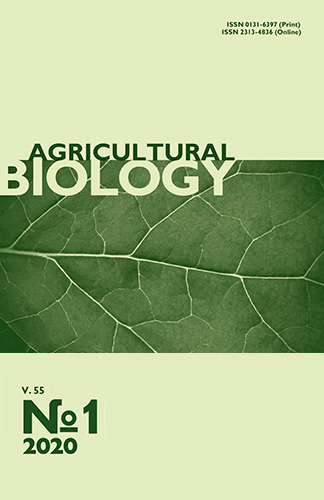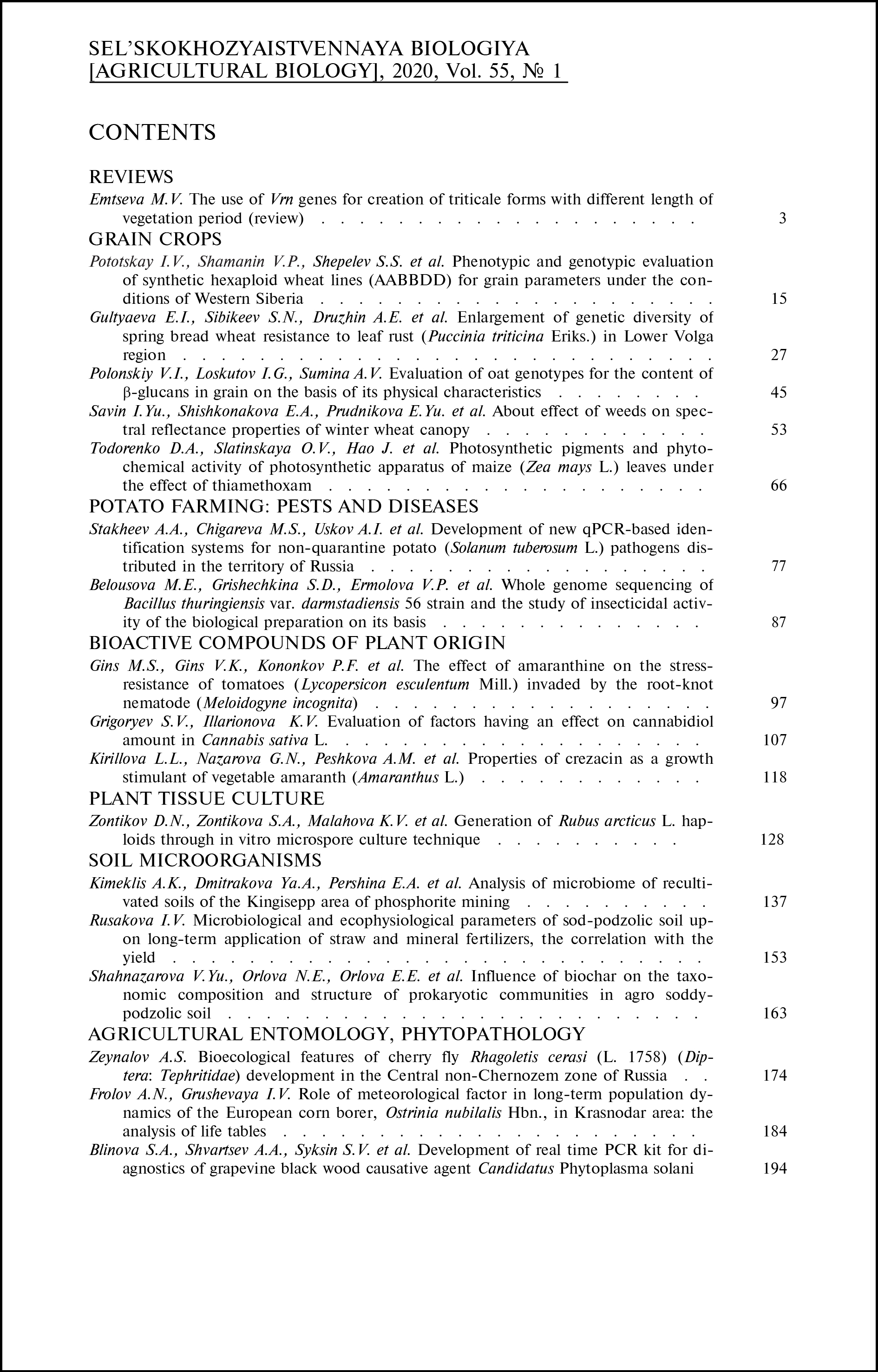doi: 10.15389/agrobiology.2020.1.77eng
UDC: 635.21:632.3.01/.08:577.2.08
Acknowledgements:
The article was prepared as part of the Federal Program for the Development of Agriculture of the Russian Federation for 2017-2025 (Sub-Program “Potato breeding and seed production”).
DEVELOPMENT OF NEW qPCR-BASED IDENTIFICATION SYSTEMS FOR NON-QUARANTINE POTATO (Solanum tuberosum L.) PATHOGENS DISTRIBUTED IN THE TERRITORY OF RUSSIA
A.A. Stakheev1, M.S. Chigareva1, A.I. Uskov2, I.V. Shmyglya2,
Yu.A. Varitsev2, P.A. Galushka2, S.K. Zavriev1
1Shemyakin-Ovchinnikov Institute of Bioorganic Chemistry RAS, 16/10, ul. Miklukho-Maklaya, Moscow, 117997 Russia, e-mail stakheev.aa@gmail.com (✉ corresponding author), magyter@yandex.ru, szavriev@ibch.ru;
2Lorkh All-Russian Research Institute of Potato Farming, 23, ul. Lorkha, pos. Korenevo, Lyubertsy Region, Moscow Province, 140051 Russia, e-mail korenevo2000@mail.ru, i.shmyglya@mail.ru, varyuriy@yandex.ru, pavel_galushka@mail.ru
ORCID:
Stakheev A.A. orcid.org/0000-0002-0732-5321
Varitsev Yu.A. orcid.org/0000-0002-2329-7965
Chigareva M.S. orcid.org/0000-0002-2940-5410
Galushka P.A. orcid.org/0000-0003-4680-9684
Uskov A.I. orcid.org/0000-0003-1596-8359
Zavriev S.K. orcid.org/0000-0002-6741-8175
Shmyglya I.V. orcid.org/0000-0002-4727-7141
Received October 22, 2019
Russia is among the largest potato producers in the world. According to statistics for 2018, the sown area of potatoes amounted to 310.7 thousand ha, which is 3.5 % more than in 2017, and the gross harvest in the industrial sector is 7157 thousand tons. At the same time, potatoes are susceptible to infection by various plant pathogens of different taxonomic groups. In modern potato growing, the progressive spread of viral and bacterial diseases, which, in addition to reducing the yield, causes a catastrophic deterioration of tubers’ quality, leads to a serious problem for commercial production. Not all dangerous pathogens belong to quarantine organisms in Russia. However, the need for their accurate and highly specific identification is not less than for quarantine organisms. Currently, classic diagnostic methods in potato growing are indicator plants, serological and cytological tests. They are relatively reliable, but not always sensitive enough, time-consuming and their use requires highly qualified personnel. A modern alternative to these methods are diagnostic systems based on polymerase chain reaction (PCR), in particular, its real-time modification (quantitative PCR, qPCR). In the present study, for the first time in Russia, qPCR-based tests were developed for six non-quarantine pathogens — necrotic strains of potato virus Y (PVYN-NTN and PVYN:O), tobacco rattle virus (TRV), and pathogenic bacteria Dickeya solani, D. dianthicola, and Pectobacterium atrosepticum. Primers and fluorescent-labeled probes were designed based on nucleotide sequences presented in the NCBI GenBank international database for the amplicon size not more than 500 bp. The specificity of the proposed systems was shown in tests with the genetic material of pathogens that infect potatoes, which are taxonomically close or occupy similar ecological niches, such as the ordinary strain PVY, potato mop-top virus, Pectobacterium carotovorum, and D. zeae. The quality of the proposed test systems was also evaluated using plant material, presumably infected with the analyzed pathogens. Nucleic acids were isolated using Proba-NK (for RNA) and Proba-GS (for DNA) reagents (AgroDiagnostica LLC, Russia). For the reverse transcription reaction, the RevertAid Premium First Strand cDNA Synthesis Kit (Thermo Scientific, USA) was used. PCR was carried out in the Tertsik amplifier (DNA-technology, Russia), and quantitative PCR was performed in the DT-96 detection amplifier (DNA-technology, Russia). To assess possible inhibition, an internal control sample (IC, a plasmid with a specific 560 bp insert) was added to the reaction mixture. Positive control samples (PCs) were cloned using the Quick-TA kit (Evrogen, Russia). Plasmid DNA concentration was determined (a NanoVue spectrophotometer, GE HealthCare, USA). DNA molecules were sequenced (an ABI PRISM 3730 automated sequencer, Applied Biosystems, USA). Analytical sensitivity was evaluated by quantitative PCR, in which sequential 10-fold dilutions of plasmid DNA (PC in four independent replicates) in the range of 107 to 100 copies per reaction were used as matrices. High sensitivity of the developed test systems, ranging from 10 to 500 copies of specific DNA per reaction, as well as high reproducibility (Cv 1.5-2.0 %) were shown. The maximum fluorescence increase for the developed hydrolyzed probes ranged from 1200 to 2000 units of background. The universality of the proposed amplification profiles can serve as the basis for adapting test systems to the multiplex PCR format. The obtained results indicate that these systems detect the analyzed pathogens with high specificity and sensitivity and can be used as part of phytosanitary control and routine diagnosis of 6 non-quarantine pathogens in plants, planting material and food products.
Keywords: diagnostics, quantitative PCR, sensitivity, specificity, Pectobacterium atroseptic.
REFERENCES
- Oerke E.-C. Crop losses to pests. The Journal of Agricultural Science,2006, 144(1): 31-43 CrossRef
- Malko A., Frantsuzov P., Nikitin M., Statsyuk N., Dzhavakhiya V., Golikov A. Potato pathogens in Russia’s regions: an instrumental survey with the use of real-time PCR/RT-PCR in matrix format. Pathogens,2019, 8(1): 18 CrossRef
- Govorov D.N., Zhivykh A.V., Novoselov E.S., Golikov A.G. Zashchita i karantin rastenii, 2015, 7: 35-37 (in Russ.).
- Shlyakhov V.A., Grigoryan L.N. Zhivye i biokosnye sistemy, 2017, 21: 6 (in Russ.).
- GOST 33996-2016. Kartofel' semennoi. Tekhnicheskie usloviya i metody opredeleniya kachestva [GOST 33996-2016. Potato seed. Technical conditions and methods for quality esimation]. Moscow, 2017 (in Russ.).
- Gera A., Marco S. Detection and identification of viruses in potatoes. In: Virus and virus-like diseases of potato and production of seed-potatoes. G. Loebenstein, P.H. Berger, A.A. Brunt, R.H. Lawson (eds.). Springer, Dordrecht, 2000: 271-283 CrossRef
- Anisimov B.V., Belov G.L., Varitsev Yu.A., Elanskii S.N., Zhuromskii G.K., Zavriev S.K., Zeiruk V.N., Ivanyuk V.G., Kuznetsova M.A., Plyakhnevich M.P., Pshechenkov K.A., Simakov E.A., Sklyarova N.P., Stashevski Z., Uskov A.I., Yashina I.M. Zashchita kartofelya ot boleznei, vreditelei i sornyakov [Protecting potatoes from diseases, pests and weeds]. Moscow, 2009 (in Russ.).
- Chrzanowska M. New isolates of the necrotic strain of potato virus Y (PVYN) found recently in Poland CrossRef
- Visser J.C., Bellstedt D.U., Pirie M.D. The recent recombinant evolution of a major crop pathogen potato virus Y. PLoS ONE, 2012, 7(11): e50631 CrossRef
- Ribeiro S.R.R.P., Pinto C.A.B.P, Costa S.B.F.G., Menezes M., dos Reis Figueira A.R. Resistance of potato clones to necrotic recombinant strains of potato virus Y (PVY). Ciência e Agrotecnologia, 2014, 38(4): 343-351 CrossRef
- Dougherty W.G., Carrington J.C. Expression and function of polyviral gene products. Annual Review of Phytopathology, 1988, 26: 123-143 CrossRef
- Hu X., Karasev A.V., Brown C.J., Lorenzen J.H. Sequence characteristics of potato virus Y recombinants. Journal of General Virology, 2009, 90(12): 3033-3041 CrossRef
- Kozyreva N.I., Romanenko N.D. Parazitologiya, 2008, 42(5): 428-434 (in Russ.).
- Romanenko N.D., Kozireva N.I. Investigations of trichodorid nematodes (Nematoda: Trichodoridae) and tobraviruses in Russia. Russian Journal of Nematology, 1998, 6(1): 77.
- Vlasov Yu.I. Zakonomernosti razvitiya virusnykh epifitotii [Patterns of development of viral epiphytoties]. Moscow, 1974 (in Russ.).
- Larina E.I., Teploukhova T.N. Zashchita rastenii, 1975, 3: 51 (in Russ.).
- Rogozina E.V., Mironenko N.V., Afanasenko O.S., Matsukhito Yu. Vestnik zashchity rastenii, 2016, 4(90): 24-33 (in Russ.).
- Cooper J.I. The distribution in Scotland of tobacco rattle virus and its nematode vectors in relation to soil type. Plant Pathology, 1971, 20(2): 51-58 CrossRef
- Beuch U., Persson P., Edin E., Kvarnheden A. Necrotic diseases caused by viruses in Swedish potato tubers. Plant Pathology, 2014, 63(3): 667-674 CrossRef
- Yellareddygari S.K.R., Brown C.R., Whitworth J.L., Quick R.A., Hamlin L.L., Gudmestad N.C. Assessing potato cultivar sensitivity to tuber necrosis caused by Tobacco rattle virus. Plant Disease, 2018, 102(7): 1376-1385 CrossRef
- Minson T., Dabby G. 3'-terminal oligonucleotide fragments of tobacco rattle virus ribonucleic acids. Journal of Molecular Biology, 1973, 77(2): 337-340 CrossRef
- Crosslin J.M., Hamm P.B., Kirk W.W., Hammond R.W. Complete genomic sequence of a Tobacco rattle virus isolate from Michigan-grown potatoes. Archives of Virology, 2010, 155(4): 621-625 CrossRef
- Kim Y.J., Lim M.S., Kim S.M., Ryu K.H., Choi S.H. Molecular characterization of the Tobacco rattle virus RNA2 genome isolated from Gladiolus. Acta Biologica Hungarica, 2015, 66(2): 222-230 CrossRef
- Ignatov A.N. Kartofel' i ovoshchi, 2011, 5: 28-29 (in Russ.).
- Toth I.K., van der Wolf J.M., Saddler G., Lojkowska E., Hélias V., Pirhonen M., Tsror (Lakhim) L., Elphinstone J.G. Dickeya species: an emerging problem for potato production in Europe. Plant Pathology, 2011, 60(3): 385-399 CrossRef
- Shneider M.M., Kabanova A.P., Korzhenkov A.A., Miroshnikov K.K., Thi N.H.V., Toshchakov S.V., Miroshnikov K.A., Ignatov A.N. Draft genome sequence of Pectobacterium atrosepticum PB72 and complete genome sequence of the specific bacteriophage PP90. Genome Announcements, 2018, 6: e00473-18 CrossRef
- Khayi S., Blin P., Chong T.M., Robic K., Chan K.-G., Faure D. Complete genome sequences of the plant pathogens Dickeya solani RNS 08.23.3.1.A and Dickeya dianthicola RNS04.9. Genome Announcements, 2018, 6: e01447-17 CrossRef
- Li X., Ma Y., Liang S., Tian Y., Yin S., Xie S., Xie H. Comparative genomics of 84 Pectobacterium genomes reveals the variations related to a pathogenic lifestyle. BMC Genomics, 2018, 19(1): 889 CrossRef
- Ryazantsev D.Yu., Zavriev S.K. An efficient diagnostic method for the identification of potato viral pathogens. Molecular Biology, 2009, 43(3): 515-523 CrossRef
- Saitou N., Nei M. The neighbour-joining method: a new method for reconstructing phylogenetic trees. Molecular Biology and Evolution, 1987, 4(4): 406-425 CrossRef
- Bustin S.A., Benes V., Garson J.A., Hellemans J., Huggett J., Kubista M., Mueller R., Nolan T., Pfaffl M.W., Shipley G.L., Vandesompele J., Wittwer C.T. The MIQE guidelines: minimum information for publication of quantitative real-time PCR. Clinical Chemistry, 2009, 55(4): 611-622 CrossRef
- Stakheev A.A., Ryazantsev D.Yu., Gagkaeva T.Yu., Zavriev S.K. PCR detection of Fusarium fungi with similar profiles of the produced mycotoxins. Food Control, 2011, 22(3-4): 462-468 CrossRef
- Stakheev A.A., Khairulina D.R., Zavriev S.K. Four-locus phylogeny of Fusarium avenaceum and related species and their species-specific identification based on partial phosphate permease gene sequences. International Journal of Food Microbiology, 2016, 225: 27-37 CrossRef
- Shvidchenko V.K., Khasanov V.T., Fida M.A., Beisembina B., Kharchenko P.N., Alekseev Ya.I., Blagodatskikh K.A., Kazantsev A.S., Minakova N.Yu. Vestnik Rossiiskoi akademii sel'skokhozyaistvennykh nauk, 2014, 2: 47-49 (in Russ.).
- Nie X., Singh R.R. Specific differentiation of recombinant PVYN:0 and PVYNTN isolates by multiplex RT-PCR. Journal of Virological Methods, 2003, 113(2): 69-77 CrossRef
- Potrykus M., Sledz W., Golanowska M., Slawiak M., Binek A., Motyka A., Zoledowska S., Czajkowski R., Lojkowska E. Simultaneous detection of major blackleg and soft rot bacterial pathogens in potato by multiplex polymerase chain reaction. Annals of Applied Biology, 2014, 165(3): 474-487 CrossRef
- Pritchard L., Humphris S., Saddler G.S., Parkinson N.M., Bertrand V., Elphinstone J.G., Toth I.K. Detection of phytopathogens of the genus Dickeya using PCR primer prediction pipeline for a draft bacterial genome sequences. Plant Pathology, 2013, 62(3): 587-596 CrossRef
- Zaczek-Moczydłowska M., Fleming C.C., Young G.K., Campbell K., O’Hanlon R. Pectobacterium and Dickeya species detected in vegetables in Northern Ireland. European Journal of Plant Pathology, 2019, 154(3): 635-647 CrossRef
- Mumford R.A., Walsh K., Barker I., Boonham N. Detection of Potato mop top virus and Tobacco rattle virus using a multiplex real-time fluorescent reverse-transcription polymerase chain reaction assay. Phytopathology, 2000, 90(5): 448-453 CrossRef
- Xu H., Nie J. Molecular detection and identification of potato isolates of Tobacco rattle virus. Canadian Journal of Plant Pathology, 2006, 28(2): 271-279 CrossRef
- Holeva R., Philips M.S., Neilson R., Brown D.J.F., Young V., Boutsika K., Blok V.C. Real-time PCR detection and quantification of vector trichodorid nematodes and tobacco rattle virus. Molecular and Cellular Probes, 2006, 20(3-4): 203-211 CrossRef












